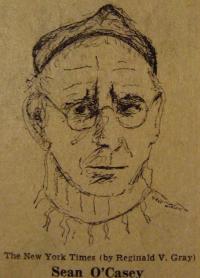O’Casey’s depiction of women
Published in 20th Century Social Perspectives, 20th-century / Contemporary History, Features, Issue 5 (Sept/Oct 2011), Volume 19
Seán O’Casey—courted criticism for his portrayal of women as symbols of domesticity and passivity, underplaying their role in the armed struggle. (Reginald V. Gray, New York Times)
Both O’Casey’s and the Independent’s women in distress, one fictional, the other (semi-)real, are equally outlandish and—amid the chaos of revolution—out of sync. But on a more serious level, the focus on such representations also risks ignoring how women, in the form of Cumann na mBan, were integral to the fighting—not inconsequential, bit-part-playing outsiders. The tendency to sideline women’s roles in the Rising is but one of the many issues that reverberate throughout literary depictions of the rebellion.
'
















